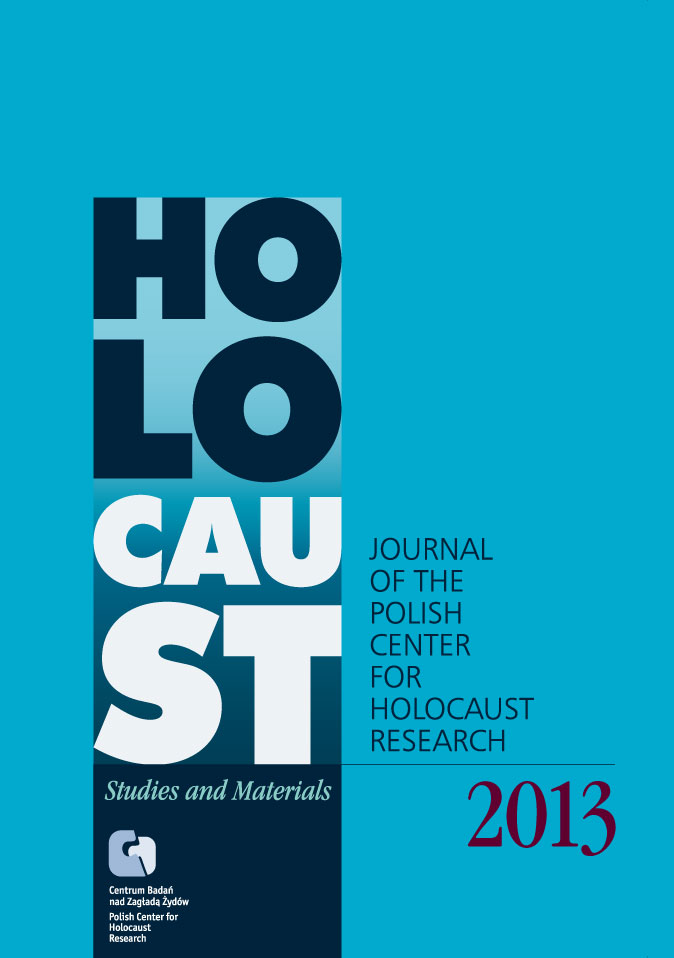Gone but not Forgotten: Archaeological approaches to the site of the former Treblinka Extermination Camp in Poland
Zagłada Żydów. Studia i Materiały, Nr Holocaust Studies and Materials (2013), Strony: 253-289
Data zgłoszenia: 2020-12-13Data publikacji: 2013-02-20
 https://doi.org/10.32927/zzsim.809
https://doi.org/10.32927/zzsim.809
Abstrakt
Public impression of the Holocaust is unquestionably centred on knowledge about, and the image of, Auschwitz-Birkenau – the gas chambers, the crematoria, the systematic and industrialized killing of victims. Conversely, knowledge of the former extermination camp at Treblinka, which stands in stark contrast in terms of the visible evidence that survives pertaining to it, is less embedded in general public consciousness. As this paper argues, the contrasting level of knowledge about Auschwitz-Birkenau and Treblinka is centred upon the belief that physical evidence of the camps only survives when it is visible and above-ground. The perception of Treblinka as having been “destroyed” by the Nazis, and the belief that the bodies of all of the victims were cremated without trace, has resulted in a lack of investigation aimed at answering questions about the extent and nature of the camp, and the locations of mass graves and cremation pits. This paper discusses the evidence that demonstrates that traces of the camp do survive. It outlines how archival research and non-invasive archaeological survey has been used to re-evaluate the physical evidence pertaining to Treblinka in a way that respects Jewish Halacha Law. As well as facilitating spatial and temporal analysis of the former extermination camp, this survey has also revealed information about the cultural memory associated with the site and how much has been forgotten about its history.
Licencja
Prawa autorskie (c) 2013 Autor & "Zagłada Żydów. Studia i Materiały"

Utwór dostępny jest na licencji Creative Commons Uznanie autorstwa 4.0 Międzynarodowe.
https://creativecommons.org/licenses/by/4.0
Inne teksty tego samego autora
- Caroline Sturdy Colls, O tym, co minęło, lecz nie zostało zapomniane: Badania archeologiczne na terenie byłego obozu zagłady w Treblince , Zagłada Żydów. Studia i Materiały: Nr 8 (2012)
Podobne artykuły
- Marta Tomczok, Literatura polska wobec Zagłady 2000 – 2024. Bilans subiektywny , Zagłada Żydów. Studia i Materiały: Nr 20 (2024)
- Jacek Leociak, Geographies of the Holocaust, red. Anne Kelly Knowles, Tim Cole, Alberto Giordano, Bloomington–Indianapolis: Indiana University Press, 2014, 260 s. , Zagłada Żydów. Studia i Materiały: Nr 14 (2018)
- Jacek Leociak, O nadużyciach w badaniach nad doświadczeniem Zagłady , Zagłada Żydów. Studia i Materiały: Nr 6 (2010)
- Yehuda Bauer, Nowogródek – historia sztetlu , Zagłada Żydów. Studia i Materiały: Nr 3 (2007)
- Nawojka Cieślińska-Lobkowicz, O wystawie „Czego nie mogliśmy wykrzyczeć światu” w Żydowskim Instytucie Historycznym w Warszawie , Zagłada Żydów. Studia i Materiały: Nr 14 (2018)
- Adam Sitarek, W obliczu „trudnej konieczności”. Administracja żydowska getta łódzkiego wobec wsiedleń Żydów z Rzeszy i Protektoratu (październik–listopad 1941 r.) , Zagłada Żydów. Studia i Materiały: Nr 8 (2012)
- Jacek Leociak, Zagłada w „Muzeum życia” (Muzeum Polin i jego kłopoty z muranowskim genius loci) , Zagłada Żydów. Studia i Materiały: Nr 11 (2015)
- Bożena Szaynok, Zatrzymane w archiwach. Wojewódzki Urząd Kontroli Prasy, Publikacji i Widowisk w Poznaniu wobec tematyki żydowskiej na łamach czasopism katolickich (1945–1950) , Zagłada Żydów. Studia i Materiały: Nr 15 (2019)
- Andrew Kornbluth, „Jest wielu Kainów pośród nas”. Polski wymiar sprawiedliwości a Zagłada, 1944–1956 , Zagłada Żydów. Studia i Materiały: Nr 9 (2013)
- Adam Kopciowski, Zajścia antyżydowskie na Lubelszczyźnie w pierwszych latach po drugiej wojnie światowej , Zagłada Żydów. Studia i Materiały: Nr 3 (2007)
<< < 5 6 7 8 9 10 11 12 13 14 15 16 17 18 19 20 21 22 23 24 25 26 27 28 29 30 31 32 33 34 35 36 37 38 39 40 41 42 43 44 45 46 47 48 49 50 51 52 53 54 > >>
Możesz również Rozpocznij zaawansowane wyszukiwanie podobieństw dla tego artykułu.
 English
English
 Język Polski
Język Polski








